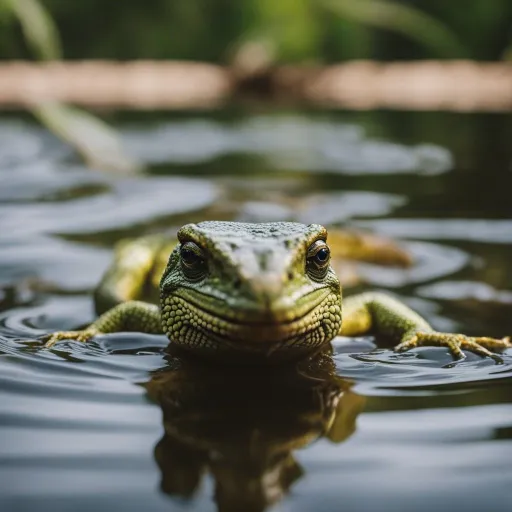
So you’ve come across a lizard and a gecko, and now you’re curious about the difference between the two. Well, you’re in the right place!
In this article, we’ll explore the distinctions between lizards and geckos, shedding light on their unique features, habitats, and behavior.
By the end, you’ll be able to tell these scaly creatures apart with ease. So, let’s jump in and discover the fascinating world of lizards and geckos!
Overview
Lizards and geckos are both reptiles, but they belong to different families and have distinct characteristics.
While they may share some similarities, such as scaly skin and the ability to regenerate their tails, there are significant differences between the two.
In this article, we will delve into the taxonomy, physical characteristics, habitat and distribution, behavior, feeding habits, reproduction, adaptations, dangerous species, and popular pet choices of both lizards and geckos.
By the end, you will have a comprehensive understanding of these fascinating reptiles.
Classification
Taxonomy
Lizards are a diverse group of reptiles belonging to the order Squamata. They are further classified into various families, each with its own unique characteristics. On the other hand, geckos are a subfamily within the larger lizard family. They belong to the family Gekkonidae, which contains over 2,000 species of geckos.
Family Classification
Lizards can be classified into several families, including Iguanidae, Scincidae, and Chamaeleonidae, among others. Each family has its own specific traits and features that distinguish them from one another. Geckos, as mentioned earlier, belong to the Gekkonidae family, which includes well-known species like the Tokay gecko and the leopard gecko.https://www.youtube.com/embed/9xRxviV6MWE
Physical Characteristics
Size
Lizards and geckos vary in size, with the smallest geckos measuring only a few centimeters in length, while some larger lizards, such as the Komodo dragon, can reach lengths of up to 10 feet. However, the average size of most lizards and geckos falls in the range of a few inches to a few feet.
Body Shape
Lizards typically have long, slender bodies with tails that can be used for balance and communication. Geckos, on the other hand, have a distinct body shape characterized by a stocky build and a tail that serves as a fat storage organ.
Skin and Scales
Both lizards and geckos have scaly skin, but the texture and pattern can differ significantly. Many lizards have rough, bumpy skin with distinct scales, while geckos often possess smooth, soft skin. Additionally, some geckos, like the tokay gecko, have specialized toe pads covered in tiny hairs that allow them to climb walls and ceilings.
Eyes
One notable difference between lizards and geckos is their eyes. Most lizards have moveable eyelids, allowing them to blink and close their eyes fully. In contrast, geckos have a transparent membrane, called a spectacle, that covers their eyes, providing protection while still allowing them to see.
Limbs
Lizards typically have four limbs, with each limb ending in distinct fingers or toes. Some lizards, such as the chameleon, have specialized gripping feet that help them navigate their arboreal habitats. On the other hand, geckos also have four limbs, but their toes are unique, often featuring adhesive pads or lamellae that aid in climbing and clinging to surfaces.
Habitat and Distribution
Environmental Preferences
Lizards and geckos inhabit diverse environments across the globe. Lizards can be found in a wide range of habitats, including deserts, forests, grasslands, and even underwater. Their environmental preferences vary depending on their species, with some lizards favoring arid conditions, while others thrive in more humid environments. Geckos, however, are often associated with tropical regions and are commonly found in warm, moist habitats like rainforests and deserts.
Geographical Distribution
Lizards and geckos can be found on every continent except Antarctica. They have managed to adapt and thrive in various regions, with specific species being more prevalent in certain parts of the world. For instance, the frilled lizard is native to Australia, while the green anole is native to the southeastern United States. Geckos, on the other hand, are especially abundant in areas such as Southeast Asia, Africa, and the Americas.

Behavior
Activity Patterns
Lizards and geckos exhibit diverse activity patterns depending on their species and the environmental conditions they inhabit. Some lizards, like the diurnal species, are most active during the day, while others, such as nocturnal geckos, are active primarily at night. However, it is essential to note that there are exceptions to these patterns, with some lizards and geckos displaying crepuscular (active during twilight) or cathemeral (active throughout the day and night) behaviors.
Communication
Lizards and geckos communicate through a variety of methods, including visual displays, vocalizations, and body movements. Many lizards engage in territorial displays, where they puff up their bodies, extend their dewlaps or frills, and change color to establish dominance or attract mates. Geckos, being primarily vocal reptiles, use a range of distinctive calls and chirps to communicate with members of their species.
Feeding Habits
Dietary Preferences
Lizards and geckos have diverse dietary preferences depending on their species and habitat. Most lizards are carnivorous, feeding on insects, small mammals, birds, and sometimes even other reptiles. Some lizards, like marine iguanas, have even developed the ability to consume algae and seaweed. In contrast, geckos are primarily insectivores, with a diet consisting mainly of insects, spiders, and other small invertebrates.
Hunting Techniques
Lizards and geckos employ different hunting techniques to capture their prey. Lizards, equipped with sharp teeth and strong jaws, often rely on their agility and speed to catch their prey. Some lizards, like chameleons, have specialized tongues that can shoot out rapidly to snag insects. Geckos, on the other hand, use their adhesive toe pads and incredible climbing abilities to stalk and capture their prey, often utilizing ambush tactics or stealthy approaches.
Reproduction
Mating Behavior
Both lizards and geckos have unique mating behaviors that vary among species. Male lizards often engage in territorial displays, where they display vivid colors, inflate throat pouches, or bob their heads to attract females. Some species may even engage in physical combat with rival males to establish dominance. Geckos, on the other hand, rely heavily on vocalizations and pheromones to attract mates, with elaborate courtship rituals and territorial behavior sometimes accompanying the mating process.
Egg-laying and Incubation
Most lizards and geckos are oviparous, meaning they lay eggs to reproduce. Female lizards usually dig a nest or find a suitable location to lay their eggs. Geckos, on the other hand, typically deposit their eggs in concealed areas, such as underneath tree bark or in rock crevices. Once laid, the eggs are left to incubate, with the temperature and humidity of the surrounding environment playing a significant role in determining the incubation period.
Parental Care
Lizards and geckos vary in their levels of parental care. While some lizards show no parental involvement after laying their eggs, others exhibit varying degrees of care. Some lizard species guard their nests, protecting the eggs from predators. In some gecko species, the female may guard the eggs until they hatch. However, it is more common for both lizards and geckos to display minimal parental care, relying on the innate survival instincts of their offspring.
Adaptations
Camouflage
Lizards and geckos have evolved remarkable camouflage adaptations to blend in with their surroundings and avoid predation. Lizards often have the ability to change color, enabling them to match the environment they are in and remain concealed from potential threats. Geckos, while not changing color like their lizard counterparts, rely on their skin texture and patterns to blend in with tree bark, rocks, or leaves. Some geckos also possess the ability to detach their tails when threatened, distracting predators while they make their escape.
Regeneration
One of the most fascinating adaptations of lizards and geckos is their ability to regenerate lost body parts, particularly their tails. If a lizard or gecko is attacked and loses its tail, it has the remarkable capability to grow a new one. This regrown tail, however, may differ slightly in appearance from the original and may lack certain specialized features. This regenerative ability provides an advantage in terms of survival, as the reptile can escape from predators by sacrificing their tail.
Dangerous Species
Venomous Lizards
While the majority of lizards are harmless to humans, some species possess venom that they use to immobilize or kill their prey. One example is the Gila monster, a venomous lizard found in the southwestern United States and Mexico. The venom is injected into their prey through grooved teeth, causing paralysis and allowing the Gila monster to consume its meal. It is important to note that while venomous, these lizards are generally not aggressive towards humans and only pose a threat when directly handled or provoked.
Poisonous Geckos
Unlike venomous lizards, geckos are not typically associated with venomous characteristics. However, a few species of geckos, such as the new Caledonian giant gecko, have been found to possess poisonous skin. The toxicity of their skin is believed to be derived from their diet, consisting of specific insects that provide them with the toxic compounds. It is advised to avoid touching or handling any wild geckos without proper knowledge of their species to prevent potential harm.
Popular Pet Choices
Common Species
Lizards and geckos make popular pet choices due to their unique appearances and relatively low maintenance requirements. Some of the most commonly kept lizard species as pets include the bearded dragon, leopard gecko, green anole, and blue-tongued skink. These species are known for their docile nature and adaptability to captivity. Geckos, particularly the leopard gecko, crested gecko, and day gecko, are also highly sought-after as pets due to their striking colors and ease of care.
Care Requirements
Caring for pet lizards and geckos involves providing them with appropriate enclosures, lighting, heating, and a well-balanced diet. Lizards often require larger enclosures with ample space to move around and bask under heat lamps. Geckos, on the other hand, thrive in well-ventilated terrariums with climbing structures and hiding spots. It is essential to research the specific care requirements of the chosen species to ensure their well-being and longevity in captivity.
Final Thoughts
In conclusion, while lizards and geckos share some similarities, they also have distinct characteristics, behavior patterns, and adaptations.
Understanding their taxonomy, physical attributes, habitat preferences, feeding habits, and reproductive behaviors allows us to appreciate the uniqueness of these reptiles.
Whether you encounter them in the wild or choose to keep them as pets, lizards and geckos are undoubtedly intriguing creatures that continue to captivate the hearts of reptile enthusiasts worldwide.



